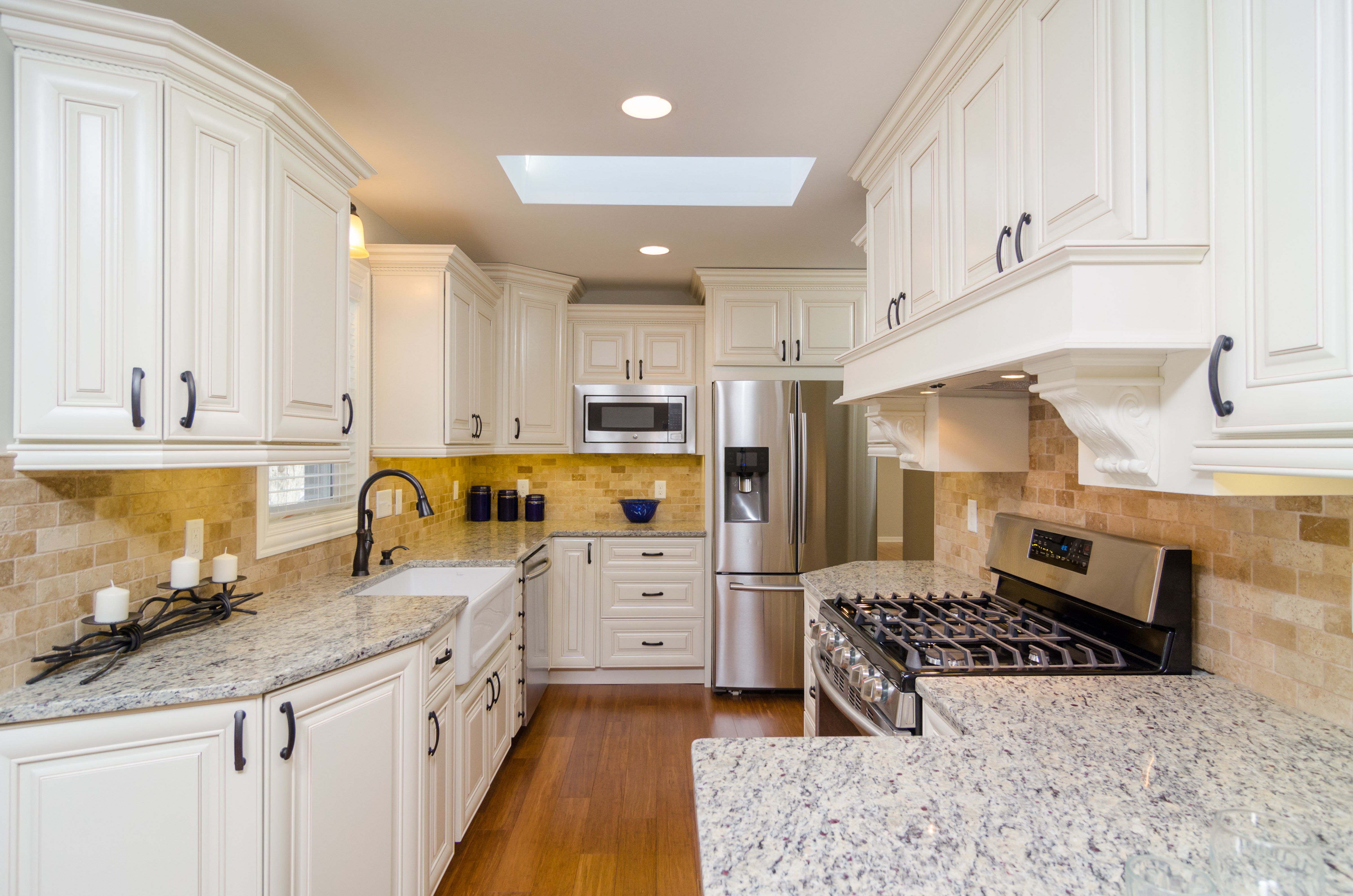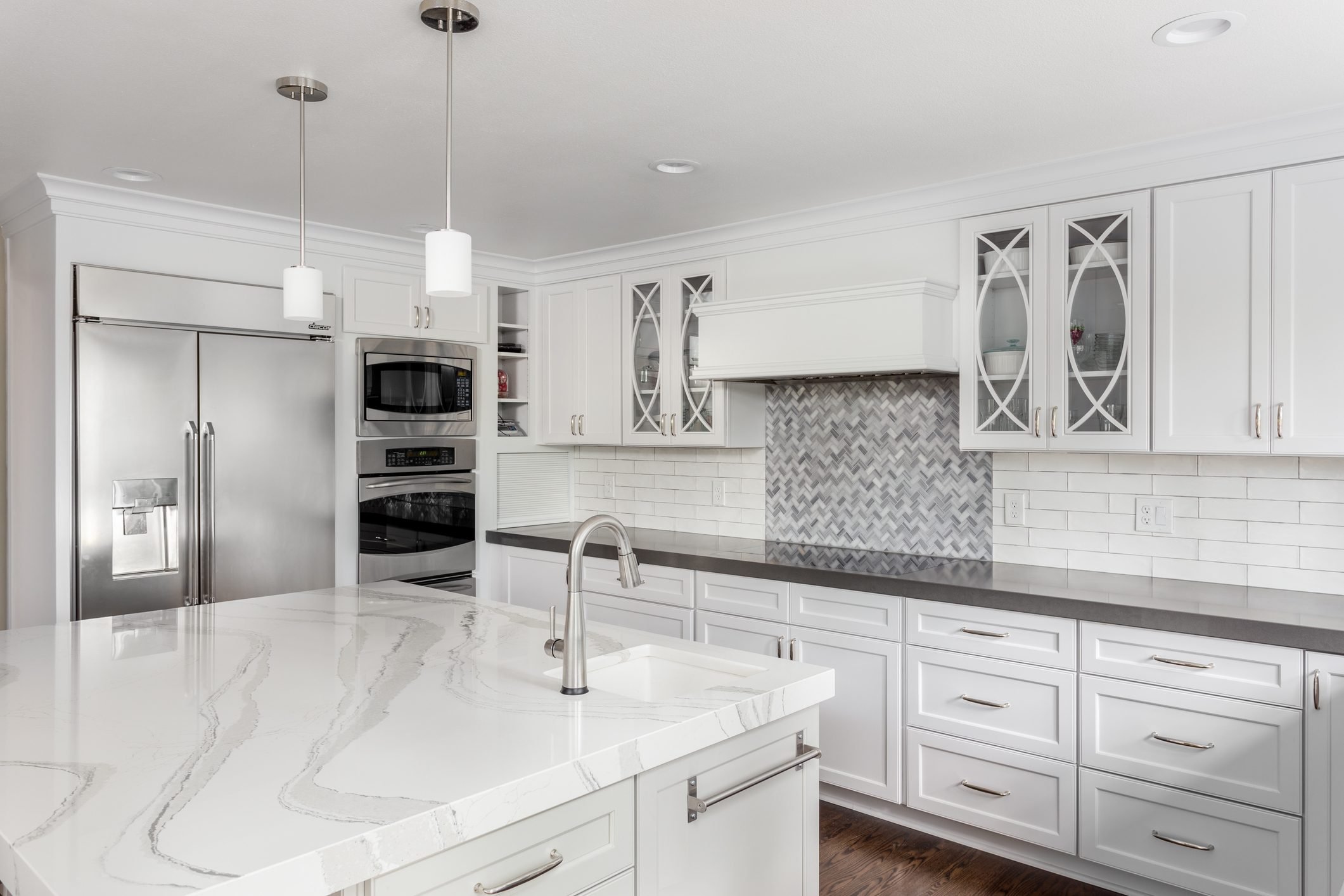Cleaning Methods for White Kitchen Cabinets

Maintaining the pristine appearance of white kitchen cabinets requires consistent cleaning and care. The choice of cleaning method depends on factors such as the severity of the grime, the available time, and personal preference for DIY versus professional solutions. This section explores various approaches, weighing their pros and cons.
Comparison of Cleaning Methods for White Kitchen Cabinets
Choosing the right cleaning method for your white kitchen cabinets involves considering cost, effectiveness, time commitment, and environmental impact. The following table provides a comparison of different options:
| Cleaning Method | Cost | Effectiveness | Time Required | Environmental Impact |
|---|---|---|---|---|
| DIY Baking Soda & Vinegar | Low (ingredients readily available) | Moderate (effective for light grime and grease) | Moderate (depending on cabinet size and condition) | Low (natural ingredients) |
| Commercial Cabinet Cleaner | Moderate (purchase required) | High (formulated for grease and grime removal) | Moderate | Moderate (depends on cleaner ingredients) |
| Professional Cleaning Service | High (service fees) | High (thorough cleaning and potential restoration) | Low (service provider handles the work) | Variable (depends on the service provider’s practices) |
Step-by-Step Guide: Cleaning with Baking Soda and Vinegar
This method is cost-effective and environmentally friendly for maintaining clean white kitchen cabinets.
- Preparation: Gather your supplies: a spray bottle filled with equal parts water and white vinegar, a soft cloth or sponge, a bowl of baking soda, and a clean microfiber cloth for drying. [Image: A table showing the gathered supplies: spray bottle, soft cloth, bowl of baking soda, and microfiber cloth.] This image would depict each item clearly labeled and arranged neatly.
- Pre-Cleaning: Remove any loose debris or crumbs from the cabinet surfaces using a dry brush or cloth. [Image: A hand using a soft brush to gently remove crumbs from a cabinet surface.] The image would highlight the gentle brushing motion to avoid scratching.
- Applying the Solution: Spray the vinegar solution onto a section of the cabinets. Avoid over-saturation. [Image: A hand spraying the vinegar solution onto a cabinet door. The spray is even and not excessive.] This image emphasizes controlled spraying.
- Scrubbing: Sprinkle a small amount of baking soda onto the damp surface. Using a soft cloth or sponge, gently scrub the cabinets in a circular motion. [Image: A hand gently scrubbing a cabinet door with a soft cloth and baking soda paste. The motion is circular and gentle.] The image would showcase the even application of baking soda and gentle scrubbing.
- Rinsing: Wipe away the baking soda residue with a damp cloth. [Image: A hand wiping a cabinet door with a damp cloth, removing the baking soda paste.] The image would demonstrate effective removal of the paste.
- Drying: Dry the cabinets thoroughly with a clean microfiber cloth to prevent water spots. [Image: A hand drying a cabinet door with a clean microfiber cloth, ensuring a streak-free finish.] This image would show the use of a microfiber cloth for effective drying.
Preventing Future Stains and Damage
Proactive measures significantly reduce the need for intensive cleaning and help maintain the cabinets’ appearance.
Regular wiping down of surfaces after spills and cooking prevents grease and grime buildup. Using coasters and placemats under glasses and dishes protects against water rings and stains. Avoid using harsh abrasive cleaners or scouring pads, which can scratch the cabinet surfaces. Consider applying a protective sealant periodically to enhance stain resistance. Regular dusting helps prevent the accumulation of dirt and grime. Promptly addressing spills and sticky residue minimizes the risk of permanent staining. Using appropriate cleaning products designed for kitchen cabinets will help avoid damage.
Dealing with Specific Stains on White Kitchen Cabinets: Cleaning White Kitchen Cabinets

Maintaining the pristine appearance of white kitchen cabinets requires addressing various stains effectively. Different materials require tailored cleaning approaches to prevent damage. Understanding the proper techniques and cleaning agents is crucial for preserving the beauty and longevity of your cabinets.
Grease Stain Removal
Grease stains are a common occurrence in kitchens. These stains can range from light smudges to heavier build-ups, depending on the cooking habits. Prompt attention is key to preventing grease from becoming deeply embedded in the cabinet’s finish.
- Mild Soapy Water: For light grease stains, a solution of warm water and a mild dish soap is often sufficient. Apply the solution with a soft sponge or cloth, gently scrubbing the area. Rinse thoroughly with clean water and dry immediately with a soft cloth.
- Baking Soda Paste: For more stubborn grease, create a paste of baking soda and water. Apply the paste to the stain, let it sit for a few minutes, then gently scrub with a soft brush or cloth. Rinse and dry completely.
- Commercial Degreaser: In cases of heavy grease accumulation, a commercial degreaser specifically designed for kitchen use can be effective. Always follow the manufacturer’s instructions carefully, testing a small inconspicuous area first to ensure it doesn’t damage the finish. Ensure adequate ventilation while using such products.
Coffee Stain Removal
Coffee spills can leave unsightly dark marks on white cabinets. The longer the stain sits, the more difficult it becomes to remove. Acting quickly is essential for effective stain removal.
- Immediate Wipe-Down: The most effective method is to immediately wipe up any coffee spills with a clean, damp cloth. This prevents the stain from setting.
- Mild Dish Soap and Water: For set-in stains, try a solution of mild dish soap and warm water. Gently scrub the stain with a soft sponge or cloth. Rinse thoroughly and dry.
- Magic Eraser: A melamine foam sponge, commonly known as a Magic Eraser, can be effective on stubborn coffee stains. Use it gently to avoid scratching the cabinet surface. Always test it on an inconspicuous area first.
Crayon Mark Removal
Crayon marks, especially from children, can be a persistent challenge. The waxy nature of crayons requires specific approaches to remove them without damaging the cabinet finish.
- Petroleum Jelly: Apply a small amount of petroleum jelly directly to the crayon mark. Let it sit for a few minutes to soften the wax, then gently wipe it away with a soft cloth. This method is particularly effective on wood cabinets.
- Hair Dryer and Cloth: Heat the crayon mark with a hair dryer on a low setting to soften the wax. Gently wipe away the softened wax with a clean cloth. This method works well for both wood and laminate cabinets.
- Isopropyl Alcohol (Rubbing Alcohol): For stubborn crayon marks, isopropyl alcohol (70% concentration) can be effective. Apply a small amount to a clean cloth and gently rub the stain. Always test in an inconspicuous area first. This is generally suitable for laminate surfaces but should be used cautiously on wood.
Stain Removal Techniques Comparison
| Stain Type | Wood Cabinets | Laminate Cabinets |
|---|---|---|
| Grease | Mild soapy water, baking soda paste, commercial degreaser (used cautiously) | Mild soapy water, baking soda paste, commercial degreaser |
| Coffee | Immediate wipe-down, mild soapy water, Magic Eraser (used cautiously) | Immediate wipe-down, mild soapy water, Magic Eraser |
| Crayon | Petroleum jelly, hair dryer and cloth | Hair dryer and cloth, isopropyl alcohol (used cautiously) |
Safe Use of Commercial Cleaning Products, Cleaning white kitchen cabinets
Commercial cleaning products can be effective but require careful handling. Always read and follow the manufacturer’s instructions precisely. Wear appropriate protective gear, such as gloves and eye protection, to minimize risks. Ensure adequate ventilation in the area to avoid inhaling harmful fumes. Test any product on a small, inconspicuous area before applying it to the entire cabinet surface. Never mix different cleaning products, as this can create dangerous chemical reactions.
Maintaining and Protecting White Kitchen Cabinets

Maintaining the pristine beauty of white kitchen cabinets requires a proactive approach encompassing regular cleaning, preventative measures, and occasional protective treatments. Neglecting these aspects can lead to premature wear and tear, diminishing the aesthetic appeal and longevity of your cabinets. This section details a comprehensive maintenance schedule and addresses common issues to help you preserve your investment.
A Preventative Maintenance Schedule for White Kitchen Cabinets
A regular maintenance schedule is key to preventing significant damage and keeping your cabinets looking their best. Consistency is crucial; small, regular efforts are far more effective than infrequent, intensive cleaning sessions. The following schedule Artikels a practical approach:
- Daily Wipe-Down: Quickly wipe down cabinet doors and surfaces with a damp microfiber cloth after cooking or spills to prevent stains from setting. This simple step significantly reduces long-term cleaning needs.
- Weekly Cleaning: Perform a more thorough cleaning using a gentle, non-abrasive cleaner and a soft sponge or cloth. Focus on areas prone to grease buildup, such as handles and areas near the stove.
- Monthly Inspection: Inspect all cabinets for any signs of damage, such as scratches, dents, or water damage. Address minor issues promptly to prevent them from worsening.
- Quarterly Deep Clean: Use a slightly more powerful cleaner (following manufacturer’s instructions) to tackle stubborn grime and grease. Pay close attention to corners and crevices.
- Annual Protective Treatment: Apply a high-quality wood sealant or protective finish to maintain the cabinets’ integrity and prevent moisture damage. This is especially important in humid climates.
Common Issues and Preventative Measures for White Kitchen Cabinets
White cabinets, while visually stunning, are susceptible to certain issues. Understanding these challenges and implementing preventative measures will significantly extend their lifespan.
- Discoloration: Discoloration can stem from grease buildup, spills, or prolonged exposure to sunlight. Regular cleaning, using UV-protective window film where applicable, and prompt attention to spills will minimize this risk. For example, immediately wiping up spilled coffee prevents staining.
- Scratches: Scratches are inevitable, but their severity can be lessened. Using protective pads on cabinet doors when opening and closing them, avoiding harsh scrubbing with abrasive cleaners, and employing soft cloths will help prevent scratches. Minor scratches can sometimes be buffed out with a fine-grit sandpaper and a wood polish.
- Water Damage: Water damage manifests as warping, swelling, or discoloration. Promptly wiping up spills, ensuring proper ventilation in the kitchen to reduce humidity, and using sealant to protect the wood from moisture intrusion are crucial preventative measures. For instance, addressing a leaky faucet immediately will prevent significant water damage.
